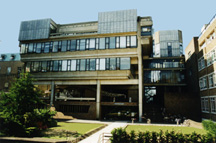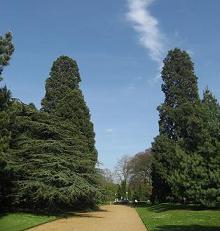
There’s loads of stuff to see and do in Cambridge related to Darwin and evolution. Darwin studied at Christ’s College of course and worked with the founders of the Sedgwick Museum and Botanical Gardens. Many of his Beagle specimens are now kept at the Zoology Museum, and you can see his microscopes at the Whipple Museum. Admission into the University museums is generally free, however donations are much appreciated. In 2009 the Darwin Festival takes place, and there will be lots of special events and exhibitions throughout the year. Use the university map to help you find things.
Christ’s College
For information about Darwin’s time at Christ’s College, how the college is celebrating their greatest student and how to visit the college please go to the Darwin & Christ’s section.
The Sedgwick Museum Of Earth Sciences
The Sedgwick Museum’s first collections were obtained by Dr. John Woodward, but were greatly extended by Darwin’s geology mentor Professor Adam Sedgwick who persuaded the university to set aside space for the museum. Sedgwick also persuaded Darwin that geology rocks (sorry!) and Darwin set off on the Beagle with the distinct aim of becoming a geologist.
The museum now has a special exhibition about how to become a geologist: Charles Darwin - Becoming a Geologist. This includes some of Darwin’s own specimens, his geological hammer and some of his notebooks. The exhibit takes the visitor through Darwin’s childhood, his early passion for collecting and his education at Cambridge then allows them to try out tools of the trade to learn more about the concepts Darwin learned from Sedgwick.

Among the museum's other evolution-themed exhibits are the Fossil Record trio which documents Ancient Life, Life in the Jurassic Seas and the Origins of Modern Life. Of particular note are the amazing 520 million year old fossils from the Burgess Shale which document the evolution of some of the earliest animals and a huge collection of trilobites, an amazing group of extinct animals which have an excellent fossil record. Of course no geology museum is complete without a collection of dinosaurs and the Sedgwick doesn’t disappoint!
Another point of interest is the exhibit on Cambridge’s local geology and how it affects us. Did you know only 2 two million years ago elephants, hippos and giant elk where among the local inhabitants?
The museum has an excellent education program and provides extensive educational materials which can be freely downloaded here. This includes a pack of teachers' notes, images and activity sheets which help teach the ‘Ideas and Evidence’ content of Key Stage 3.
The museum is located on Downing Street, is open Monday to Friday 10:00-13:00 & 14:00-17:00 and Saturday 10:00-16:00 and admission is free. School groups can also book by appointment.
The University Museum Of Zoology
The Zoology museum is in the New Museums Site off Downing Street; the entrance is directly under the huge skeleton of a Finback Whale. The museum’s collections are designated as being of outstanding national and international significance and include many of Darwin’s Zoological specimens including some of his Beagle specimens, beetles and barnacles.

Recently a new exhibition, Beetles, Finches and Barnacles: The Zoological Collections of Charles Darwin, has been made about Darwin, which includes some of his famous finches and one of the drawers from his Beetle collections. Other notable Darwin specimens include the small species of Rhea he spent weeks searching for then found on his dinner plate, and some of the huge fossil species he found in South America. The museum also has great examples of transitional fossils including many species which link fish with tetrapods, such as Acanthostega and Ichthyostega, as well as specimen uniting dinosaurs with birds, such as Archeopteryx. Read more on Darwin in the museum.
The museum is open Monday to Friday 10:00 – 16:45 and admission is free. It’s also open on Saturday mornings during the school summer holidays 10:00 – 13:00. School groups can book by appointment and you can download education material here.
The museum also runs a Young Zoologists Club for 6-12 year olds interested in animals. Members receive newsletters and get invited to special events.
The University Botanic Garden & Herbarium
The Botanic Garden was first opened to the public in 1846 and was created by Professor John Stevens Henslow who was Darwin’s mentor during his undergraduate days and his life long friend. Henslow played a major role in Darwin’s intellectual development and in getting his name known among the science community, you can read more here.

Today the gardens cover 40 acres and have displays of interest all year round including over 10,000 plant species, rock gardens, a lake, glasshouses, winter gardens and woodland walks. The gardens also boast nine national collections. Amongst the tree collections are different varieties of Pinus nigra which Henslow collected to demonstrate variability within species, a lesson which he taught to Darwin to get him thinking about variation.
The main entrance is on Bateman Street but there is also a second entrance on Hills Road near the Railway Station. The garden opens at 10:00; closing times changes through the year but the earliest close is 16:00 November – January. Admission is free to Friends of the Botanic Garden, under 16s and university members; for everyone else entrance is £4.00 for adults and £3.50 for over 60s and students.
The University also keeps a Herbarium which houses over a million plant specimens including 50,000 type specimens and the collections Darwin made during the Beagle voyage. Unfortunately it doesn’t have the facilities to open to the public, but both professional and amateur researchers can arrange viewings.
The Whipple Museum
The Whipple museum of the history of science houses a large collection of scientific instruments, apparatus and other material documenting the history of science. It is located on Free School Lane and is open to the public Monday to Friday 12:30 to 16:30 and admission is free. The collections include Charles Darwin’s microscopes which he used during his eight years working on barnacles. These microscopes were cutting edge technology in their day and gave Darwin insights into the anatomy of barnacles no one had ever seen before. You can read more about the microscopes here.
The Museum Of Archaeology And Anthropology
The University’s museum of archaeology and anthropology houses collections of artefacts from human societies around the world and those of historical societies too. Darwin was greatly interested by different human cultures and their origins and he was instrumental in settling the debate as to whether all human populations are one species. It’s easy to see why he found them so interesting when you enter the museum galleries and are surrounded by totem poles, by beautiful jewellery and ceramics, and learn about the different groups which made them. This museum is located on Downing Street and is open Tuesday to Saturday 10:30 – 16:30, admission is free.
The Fitzwilliam Museum
The Fitzwilliam is of one of Britain’s best galleries showing world class collections of many different types of art. It is located on Trumpington Street, is open Tuesday to Saturday 10:00 – 17:00 and on Sundays and Bank Holiday Mondays 12:00 – 17:00, and admission is free. In 2009 the museum has a special exhibition on: Endless Forms: Charles Darwin, Natural Science and the Visual Arts which explores Darwin’s interest in art and the Victorian art community’s response to his work.
Darwin College
Darwin College is a post-graduate college on Silver Street, founded in 1964 when the Darwin family bequeathed the buildings and grounds to the University. Charles Darwin’s son, Sir George Darwin, bought the house in 1885 and passed it on to his own son Sir Charles Darwin who died in 1962. The College has been lent many family portraits by the Darwin family and have busts of Charles Darwin and his grandfather Erasmus Darwin.
Blue Guides
The Blue Guides tour group will be running tours of Cambridge to include the major points of interest for Darwin enthusiasts, including Darwin’s room at Christ’s College. They can take groups of up to 15 round College on Saturday mornings.
The Wildlife Trust
Get out into the countryside and explore nature and biodiversity yourself with the Bedfordshire, Cambridgeshire, Northamptonshire and Peterborough Wildlife Trust!
Written by Stephen Montgomery